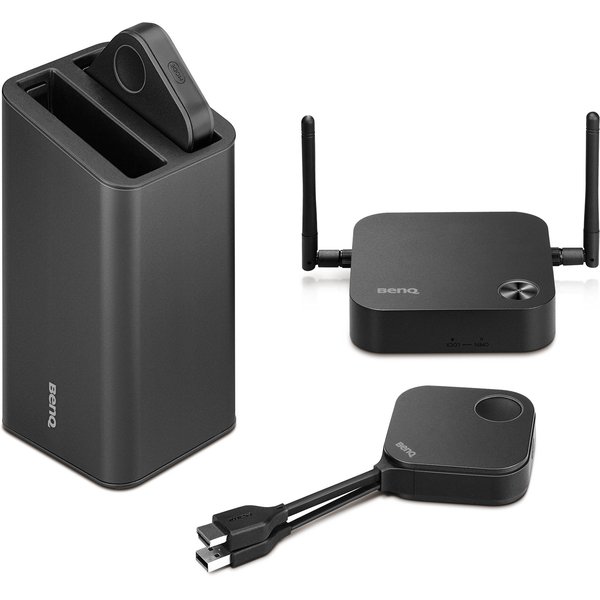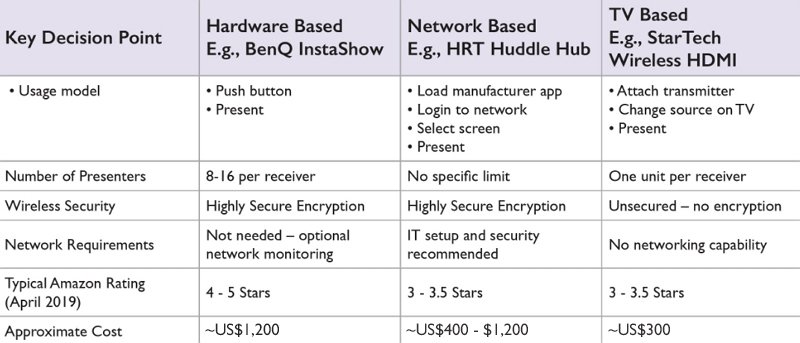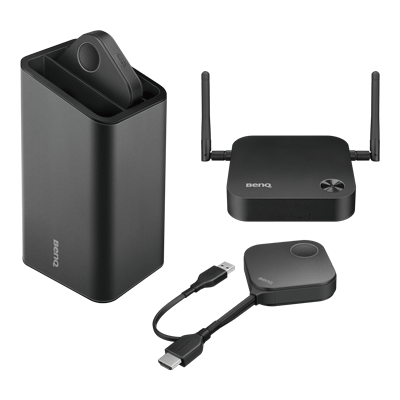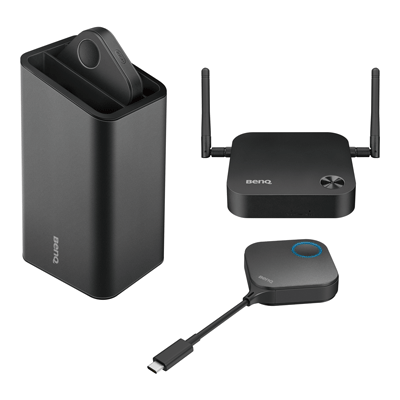How to Select a Wireless Presentation System
- BenQ
- 2019-09-13
For the last two decades, an effective conference or boardroom presentation system consisted of projectors that were connected to AV switchers, touch panels, and a lot of cables built in to the table. These systems costs typically start at US$10,000 plus custom programming.

Today’s new HDMI wireless presentation systems offer far more flexibility and ease of use – at a fraction of the cost of a traditional wired system. But how do you pick the best one for your needs? There are three major types of wireless presentation systems available today:
- Button Based Solutions – Use a physical connection to your notebook
- WiFi Network Hub Solutions – Use the company WiFi network to connect your notebook
- TV Based Wireless Transmitters – Single unit HDMI transmitter / receivers typically for consumer use
We will take a look at the three types of presentations solutions to look at the pros and cons of each system and what the trade-offs are based on your usage models. The key factors we will look at will be:
- How easy they are to use, especially for visitors?
- How much do they cost and how much IT support is needed to setup and manage?
- How do these systems secure your presentation content from hackers and unauthorized viewing?
These systems use physical button transmitter that connects to a visitor’s laptop and wirelessly transmits the HDMI signal to a receiver located near the projector or flat panel. To switch presenters, the new presenter simply presses their button and the screen switches to their notebook or device. These systems also have major security advantages of these over generic systems since the wireless signal is encrypted to keep hackers and sniffers from viewing the signal on an unauthorized receiver.
From a set up perspective, they are IT-friendly and easy to install, since the receivers set up their own hidden wireless network and don’t require any special IT support for basic functionality. They have capability to be managed over an enterprise network, and the self-contained hardware design eliminates many of the bandwidth issues found on wireless-only solutions.
For the last two decades, an effective conference or boardroom presentation system consisted of projectors that were connected to AV switchers, touch panels, and a lot of cables built in to the table. These systems costs typically start at $10,000 plus custom programming.
The two most popular solutions using this approach are the BenQ InstaShow and Barco ClickShare. Both will work with nearly any HDMI source – including new laptops with USB-C – and can support between 8-16 sources on their entry level models. The BenQ InstaShow’s unique feature is that it does not require any special software or app to work, enabling meeting room visitors to use to quickly connect to the system.

The BenQ InstaShow WDC-10 Wireless Presentation System comes with two transmitters and a tabletop holder.
These solutions utilize the company network to enable laptops and other devices to share a screen. The system uses a receiver hub that is connected to the corporate network, similar to the receivers used in the hardware approach used by Barco and BenQ, but relies on specialized software apps to capture and transmit the signal to the correct screen over the enterprise WiFi network.
Both systems are easy to use, but the BenQ InstaShow app free design eliminates the need for visitors to load software onto their notebooks, enabling a simpler and intuitive usage by corporate visitors.
For a visitor to use a system, they will need to:
- install the manufacturer’s display application software onto their notebook or device
- log onto the correct enterprise network to access the receiver
- pick the correct display receiver
This system has both USB and USB-C buttons available to enable a notebook running the ClickShare app to connect to the receiver. The ClickShare app runs on the notebook in the background and handles the video data conversion and other tasks needed for the system to work.
Some devices have special pass codes to ensure that the correct screen is connected – which prevents confidential information, such as HR data or sensitive financial information, from being routed to the wrong screen.
The primary advantage of this approach is that it eliminates the button transmitters used in the hardware-based solution. In most cases, the signals between the laptop and display are properly encrypted to ensure that a network snooper cannot view the presentation over the network. Additionally, the cost of the receivers and software is similar to the hardware-based solutions above. However, the total cost of ownership may be higher for this type of system than hardware-based solutions.

There are two primary disadvantages of the WiFi network hub-based solution. First, the system typically requires a proprietary app be loaded onto the laptop, which can be a major problem when a visitor does not have the rights – or is concerned that the software could contain malware or other hidden codes. Many companies “lock down” their notebooks from third party software to remove the threat of malware. This could delay a meeting – or cause the system to be unusable to a visitor.
The second disadvantage is that these devices need to be installed and managed by IT staff . Typically, the visitor’s notebook used for presenting must be logged on to the same network as the presentation receiver hub. Since meeting rooms represent the most exposure to external threats, these might be set up on different VLAN networks, which would require a more complicated setup and security protection from the IT department, including specific port usage. In addition, the bandwidth requirement to manage video and other rich content could require changing network priorities or settings. WiFi network solutions are completely dependent upon the performance of the corporate network. For a more detailed explanation on how different models of wireless presentation systems handle video, you can click here.
The third type of wireless HDMI solution is designed for consumers to share video content from a source, such as a game console, to a television and eliminate the need for a HDMI cable. These systems have the advantage of being less expensive than the other solutions and easy to set up. Most systems use a single transmitter that attaches to the HDMI port on a computer, with power coming from the USB port or DC power source. The receiver is attached to the display and configured with a remote.
The major disadvantage of these systems is that they do not provide any encryption or other security protection to protect the information sent from the transmitter to be received by an unauthorized third party. While this is not a major concern in a home environment transmitting a movie to a projector, it is a significant risk in a corporate or engineering environment where company information could be stolen.

The second disadvantage is that only one transmitter is linked to the receiver , making it difficult for multiple presenters to share their screens in a collaborative manner. This solution is best suited for a consumer application to overcome cabling issues or applications where there is no data confidentiality concern (such as a small house of worship). There are a number of vendors that offer these solutions including Nyrius, IoGear, and StarTech.
Here is a summary of the three different types of wireless presentation systems. Because Amazon reviews are commonly used as a buyer research tool, we provided a rough average of what their reviews were based on April 2019 ratings. These reviews will change over time, and are provided only as a general guideline for the more popular units in their category.


